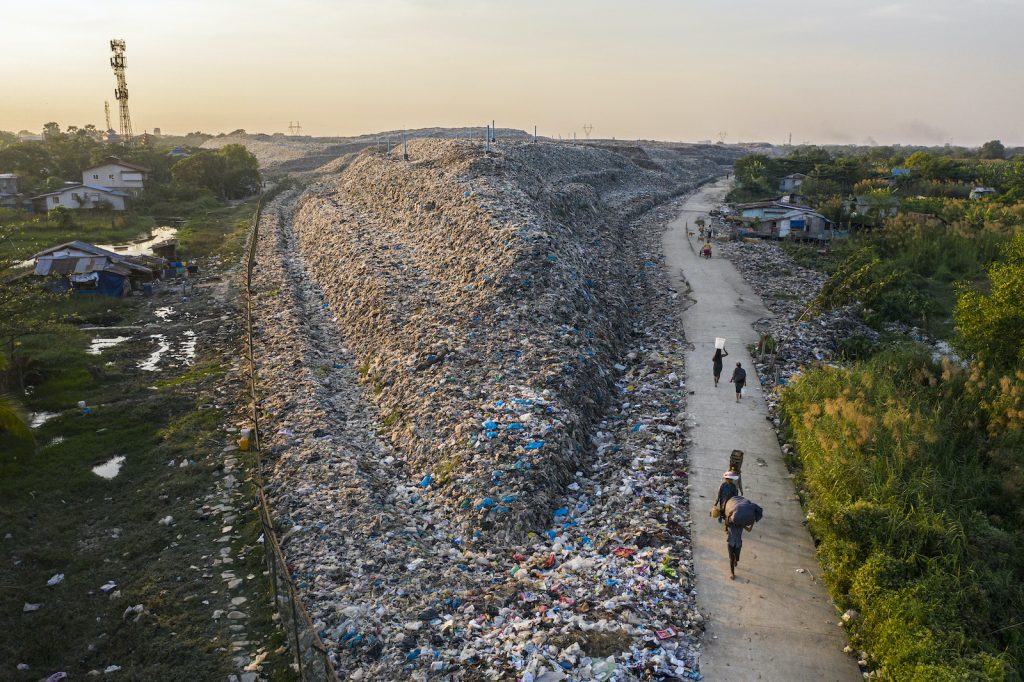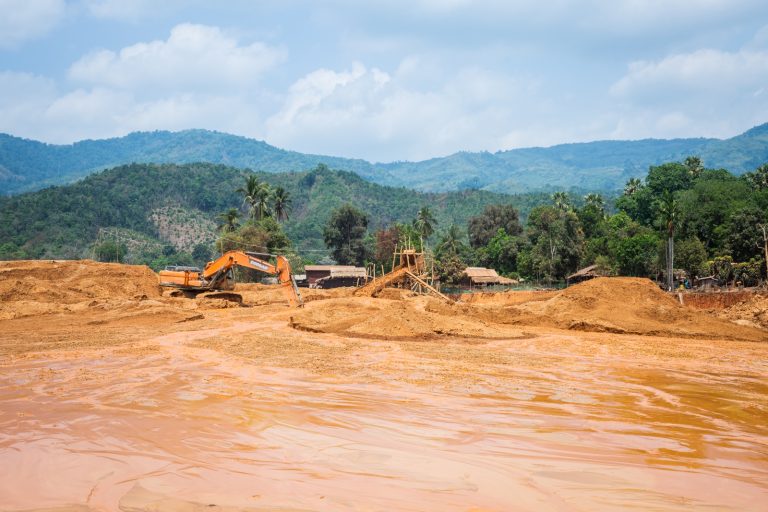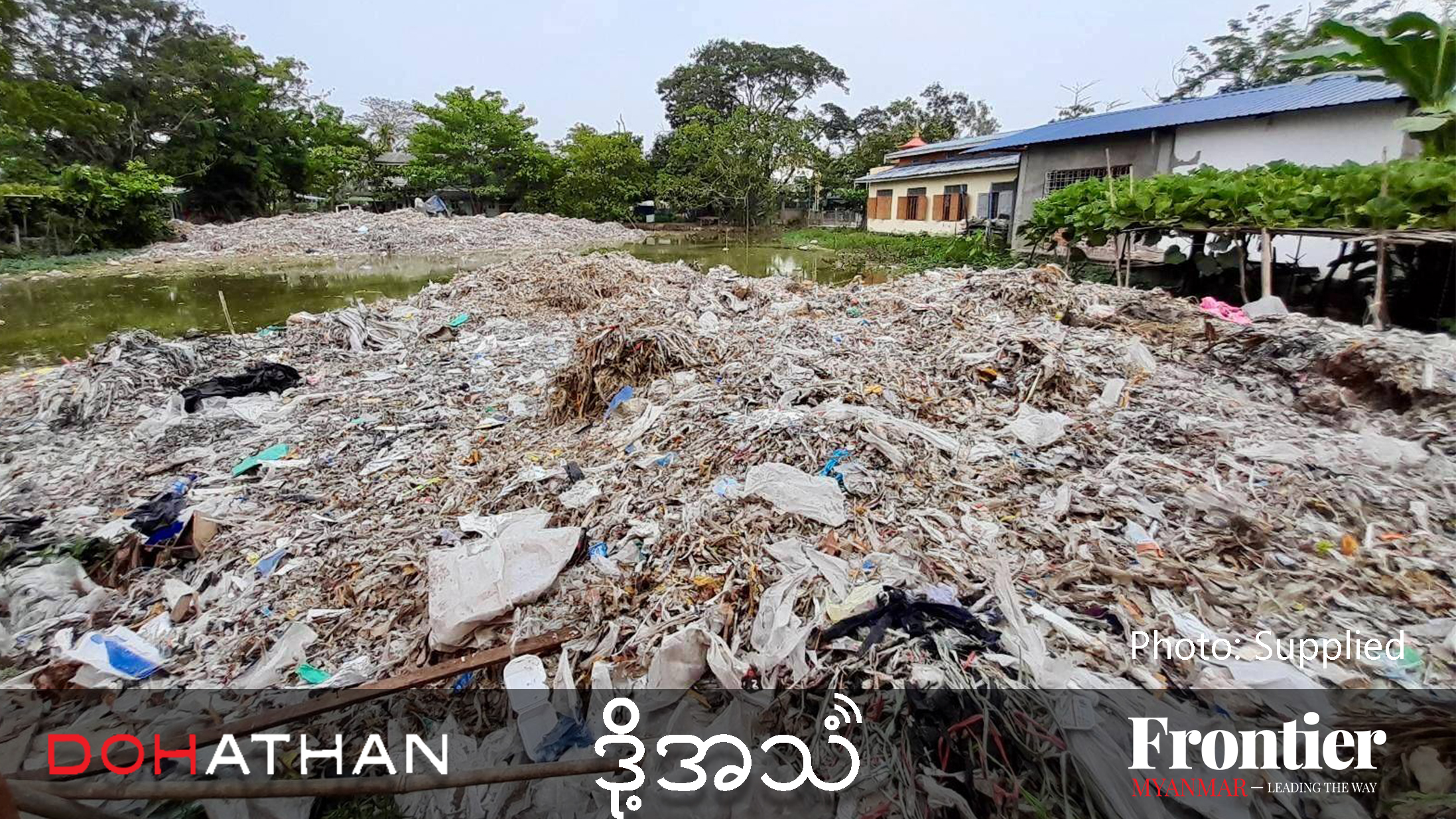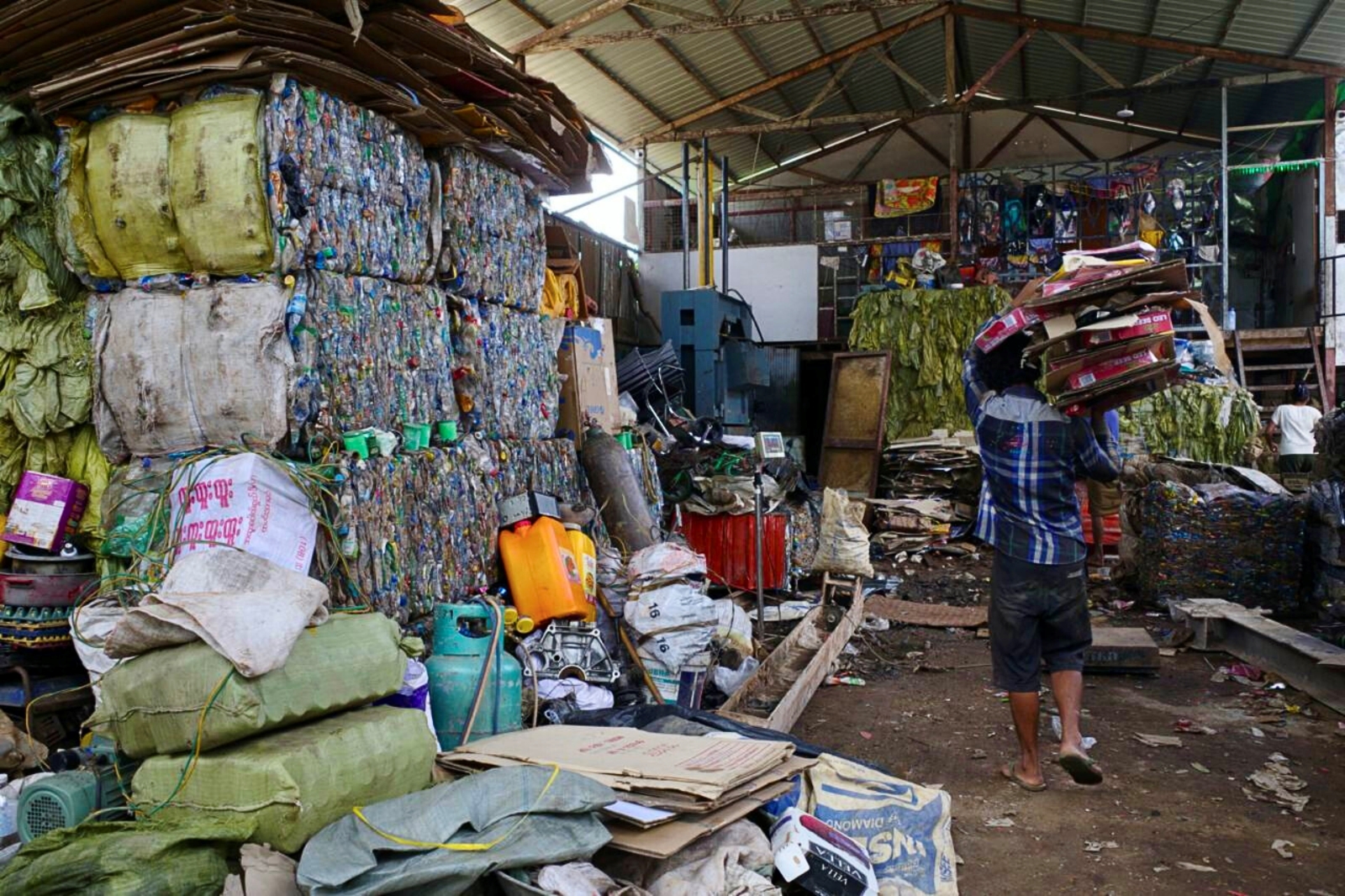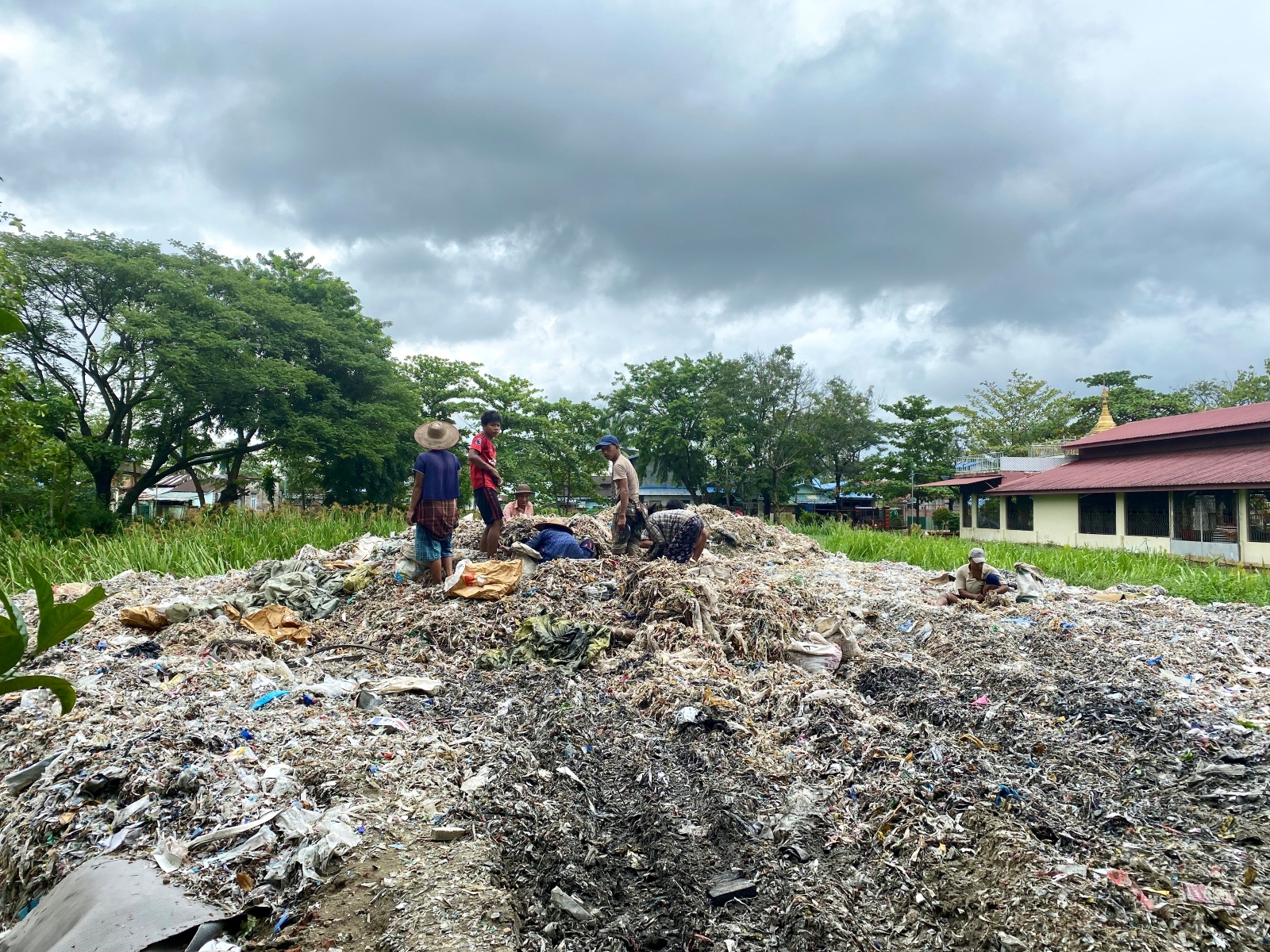A sharp increase in household plastic waste amid COVID-19 has exacerbated the threat posed by Yangon’s near-capacity landfills and poor waste management systems.
By HEIN THAR | FRONTIER
Since Yangon was placed under stay-at-home orders, Ma Yadanar has enjoyed the convenience of having meals delivered to her home. But she has one complaint.
“There are too many plastic bags,” she said, pulling a plastic container of Korean food from a plastic delivery bag one recent Sunday afternoon. She said she’s been ordering in about three times a week since the second round of lockdowns began in September.
For more than four months, orders from the Ministry of Health and Sports to limit the spread of COVID-19, which have barred customers from dining in at restaurants, have pushed consumers to order meals and groceries online and have them delivered to their homes. Environmental activists and groups say this has coincided with a noticeable increase in plastic waste that will harm the environment.
“I will dispose of them carefully to limit environmental harm,” she said, pointing to a neat bundle of used plastic products she keeps cleaned and separated from the rest of her trash. Despite the effort, there’s still a good chance it will all wind up in a municipal dump anyhow. By separating and cleaning it, however, she hopes her plastic refuse might be more likely to be rescued by Yangon’s informal trash recyclers.
An economic analysis of solid waste management outsourcing in Myanmar published by the Asia Foundation in 2019 described the country’s waste management system as “a patchwork of different formal and informal systems” mostly “struggling with high demand, low capacity, and limited funding.”
The system employed by the Yangon City Development Committee’s Pollution Control and Cleansing Department to separate plastic waste relies on informal, third-party trash pickers, which limits transparency and leaves the process prone to error and inefficiency. Officials from the pollution control department have regularly resisted recommendations from NGOs that the process be outsourced to private companies, insisting that it would push up trash collection prices to levels unaffordable for most residents.
A patchwork process
Garbage collection systems and rates differ between Yangon townships. In 15 inner-city townships, residents are taxed K20 a day to have the municipality empty neighbourhood street bins, to which they must individually bring their household waste. In the suburbs, that fee is K10. But the YCDC says that only about half of all city residents regularly pay these fees – a problem the Asia Foundation report also noted. Fee collection “largely relies on the goodwill of the local population (which in turn depends on the quality of service provision), and collected fees are insufficient to cover costs,” the report said.
Street bins are placed sporadically throughout neighbourhoods and it can vary from township to township how close any one household is to a bin. Some entrepreneurial garbage collectors, capitalising on homes that are more distant from municipal bins, push handcarts through neighbourhoods charging households their own fee to collect rubbish door-to-door. They do this independently of the government, but the YCDC officially condones the practice – even renting these collectors their own bins to use in less dense, more suburban districts, where there are fewer bins, for K2,500 a day.
Often, these independent collectors provide the first layer of waste separation in Yangon, salvaging plastics and other items that can be resold or recycled. “They’re not with our department – they charge households their own fee (between K200 and K300 per home),” said U Kyaw Min Tun, supervisor of the pollution control department in North Okkalapa Township in northern Yangon. “But they help keep the city clean, which is also good for us.”
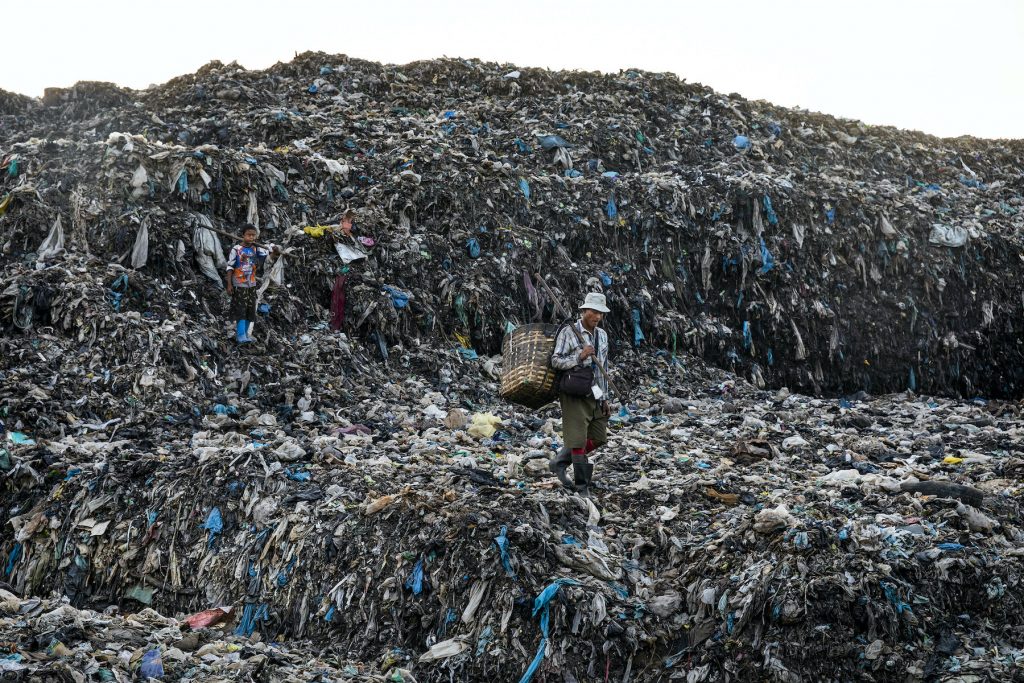
All rubbish that makes it past the first tranche of collectors and recyclers winds up at either the Htein Bin landfill, which sprawls over 90 hectares (220 acres) of outer western Hlaing Tharyar Township, or the 68ha (141-acre) Dawei Chaung dump in North Dagon Township, in Yangon’s northern outskirts.
Htein Bin, which made the news in 2018 after a fire spewing noxious smoke burned for several weeks, was established by the YCDC in 2002 on land seized by the military government in 1996 and 1997. Dawei Chaung was established in 2001. At both, rubbish is dumped without meeting environmental standards for preventing leachate from seeping into the ground.
“The landfill system is causing serious environmental destruction,” Kyaw Min Tun admits. “But at the moment there is no alternative; we are many years behind.”
The YCDC claims in promotional material to be using a 3R (reduce, reuse and recycle) garbage management system, but Frontier witnessed the city dumping waste without sorting it for re-use or recycling at both landfills. Dr Aung Myint Maw, deputy director of the YCDC’s pollution control department, said the YCDC does not operate any sorting or recycling departments or facilities.
Instead, the department licences small plastic wholesalers that operate near both dumps, then allows scavengers to pick plastic bottles, tin cans, and other waste from the trash heap and sell it to these wholesalers, who then sell it on to manufacturers of plastic products. At Dawei Chaung, this accounts for five of the average 135 tonnes of waste brought to the landfill each day, split among the 29 recycling businesses the municipality has licenced nearby.
Meanwhile, both landfills are nearing capacity. YCDC figures from 2019 project the remaining 28ha at Htein Bin to be filled in no more than five years and the 12ha left at Dawei Chaung in three, but Aung Myint Maw and other YCDC officials said they expected Dawei Chaung to reach capacity before the end of this year.
“Once these landfills reach capacity, we will have to decide whether to close them or to just keep dumping rubbish there,” said Kyaw Min Tun of the pollution control department. “Both options would be bad for the environment.”
Deputy director Aung Myint Maw said the department is planning to establish a new dump on municipal land near Yangon Region’s Pauk village, beside the Dala-Twante road, but no date is set. That would be another landfill dump void of new waste management technology, and its impact on the environment is likely to be as bad as that of Htein Bin and Dawei Chaung.
The YCDC has been working since 2013 to reduce volume and generate electricity from rubbish at the two sites but has so far been unsuccessful. A South Korean company called Chasson International was awarded a tender to build a compressed natural gas generator at Htein Bin, and a joint venture between Zeya and Associates and Hyundai Rotem was selected to build a power generating plant at Dawei Chaung, but the plans went awry when the companies were unable to negotiate power purchase agreements with the Ministry of Electric Power because of differences over pricing. YCDC officials said the price for using electricity from waste would be about K1700 a unit, which is almost double the current price of K900 a unit.
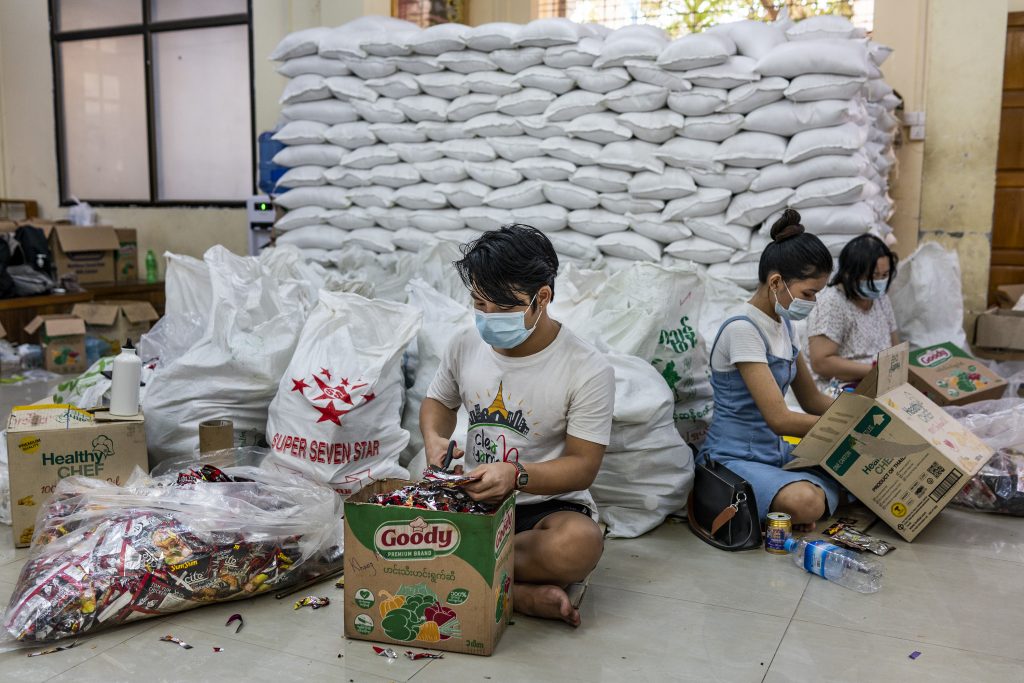
U Cho Tun Aung, who heads the YCDC’s pollution control department, said there had been no progress since in attracting companies to generate power at the two sites. He said many companies had also tried to sell waste disposal systems to the YCDC but it could not afford the cost, which would also result in an increase in garbage collection fees for the public. “A small survey we conducted found that most residents do not want to pay more for garbage collection,” he said.
In 2019, the Union government approved two foreign loans to upgrade Htein Bin. That February, Japan provided US$5.4 million for a semi-aerobic sanitary landfill, which is being implemented on 0.89ha of the 90ha site and is 90pc complete, Aung Myint Maw told Frontier on December 17. The deputy head of the pollution control department said the YCDC had also received a €50 million loan from Poland last January to build a waste-to-biogas plant. It will use a biological digester to produce compressed natural gas, liquid carbon dioxide and fertiliser, but the work is still in its infancy.
Pandemic pressure
Activists and green groups aren’t the only ones to notice an increase in plastic waste during the pandemic. The YCDC’s Aung Myint Maw has also taken note. While waste from the city’s industrial zones – which have faced sporadic shutdowns – has declined, he said plastic waste from homes, including food containers and utensils, has increased. “It has been difficult to raise public awareness about,” he told Frontier.
But, like other data in Myanmar, numbers are hard to come by. He said the department does not track waste by category or have a way to quantify an increase in plastic waste.
The apparent increase isn’t just from restaurants. Besides taking members’ temperatures and sanitising equipment between uses, gyms and swimming pools have been wrapping members’ towels in plastic, believing this might help limit the virus’s spread, and city residents have been churning through plastic visors and gloves.
Some increase in waste may be an inevitability amid such an unprecedented event. But activists say these COVID-19 prevention measures are failing to take account of the cost of all the excess plastic for the planet.
“People are using plastic without worrying about the consequences,” said Ko Zay Yar Htun, spokesperson for Clean Yangon, an advocacy group established in 2017. “We need effective campaigns and strict rules to reduce the use of plastic.”
As the landfills reach capacity, the risk is greater than just an unsightly mess. They can become dangerously unstable after being closed because of the accumulation of toxic or flammable gases under the soil. A proposal by Yangon Region Chief Minister U Phyo Min Thein to build a COVID-19 hospital on the site of a former dump in eastern Thaketa Township earlier this year was shelved because of the risk posed by toxic fumes.
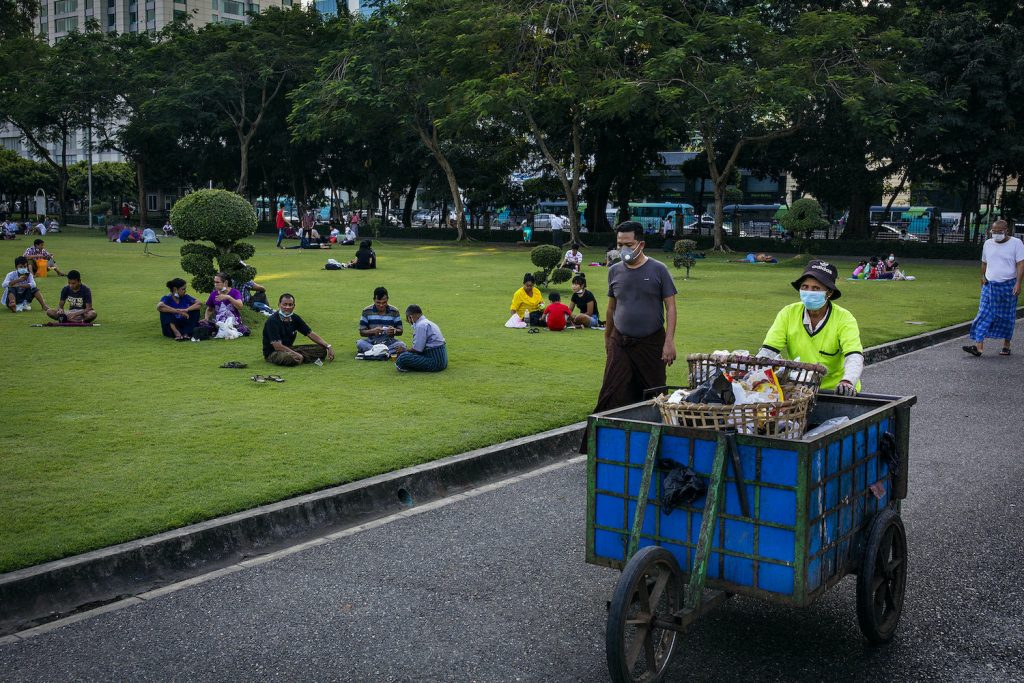
A rubbish collector at work in downtown Yangon’s Maha Bandoola Park on November 23, 2020. (Hkun Lat | Frontier)
And not all plastic waste is making it to the landfills. Aung Myint Maw noted how some city residents are burning their increased waste rather than having it collected, thereby contributing to air pollution.
The Ministry of Health and Sports has warned that air pollution is likely to cause respiratory ailments that could exacerbate the condition of anyone who contracts COVID-19. The warning comes as Yangon braces for an annual deterioration in air quality during the cool season, partly because of farmers burning off after harvesting crops, which has already resulted in air quality readings regarded as unhealthy for sensitive groups.
Dr Than Naing Soe, a spokesman for the health ministry, told Frontier that polluted air can increase the rate of respiratory infection in general and, while not directly influencing infection rates of COVID-19, it can increase the risk posed by the coronavirus should individuals become infected. “It harms your respiratory system in general,” he said. “For COVID-19 patients, this disease can be exacerbated by dirty air.”
In January, before the coronavirus had been detected in Myanmar, Amyotha Hluttaw MP U Kyaw Naing (National League for Democracy, Yangon-12) told the Pyidaungsu Hluttaw that toxic fumes from Htein Bin were causing respiratory illnesses for nearby residents. “People are unknowingly suffering from poisonous gas,” he said. “Plastic in this landfill will be poisonous for generations unless we manage it properly.”


